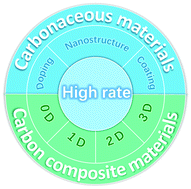Recent developments in carbon-based materials as high-rate anode for sodium ion batteries
Abstract
Sodium ion batteries (SIBs) are considered to be alternatives to lithium ion batteries (LIBs) due to the low cost and abundant reserves of sodium. Benefiting from their many similarities to LIBs, SIBs are experiencing rapid development by tracking the success of LIBs. With research developments and deeper understanding, the fast charging/discharging capability of SIBs has received intensive attention due to the fast-growing market of electronic vehicles and portable electronics. However, compared with the high-rate cathodes of SIBs, such as layered oxides and polyanionic compounds, anodes exhibit unstable performances, hindering the development of SIBs. Accordingly, significant efforts have been devoted to exploring the optimized structure and composition of high-rate anodes and encouraging progress has been recently demonstrated using carbon-based materials. In this review, we discuss major factors affecting the kinetic performance and design principle of high-rate anodes. The latest developments of carbon-based materials as high-rate anodes for SIBs are presented. Additionally, several challenges and perspectives for advanced high-rate SIBs are also summarized.

- This article is part of the themed collection: 2021 Materials Chemistry Frontiers Review-type Articles


 Please wait while we load your content...
Please wait while we load your content...